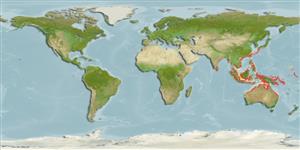Environment: milieu / climate zone / depth range / distribution range
Ökologie
seewasser demersal; tiefenbereich 30 - 40 m (Ref. 9774). Tropical
Indo-West Pacific: east Indian Ocean, throughout the Indo-Australian Archipelago to the South China Sea (Ref. 9774); recorded from the Philippines and Indonesia.
Size / Gewicht / Alter
Maturity: Lm ? range ? - ? cm
Max length : 25.0 cm SL Männchen/unbestimmt; (Ref. 9774)
Rückenflossenstacheln (insgesamt): 0; Rückenflossenweichstrahlen (insgesamt): 72-75; Afterflossenstacheln 0; Afterflossenweichstrahlen: 56 - 59. Body pale brownish, with small ocelli at junction between curved and straight portions of lateral line and another one near middle of straight section. Upper profile of head without a distinct notch or with slight notch in front of upper eye. Origin of dorsal fin slightly in front of anterior margin of upper and just above posterior nostril on blind side. Pectoral fin on ocular side with 12-13 soft rays (Ref 9774).
Inhabits shallow waters, on mud and sand bottoms of continental shelves (Ref. 9774). Feeds on small benthic animals (Ref. 9774). Marketed mostly fresh (Ref. 9774).
Life cycle and mating behavior
Geschlechtsreife | Fortpflanzung | Ablaichen | Eier | Fecundity | Larven
Distinct pairing (Ref. 205).
Gloerfelt-Tarp, T. and P.J. Kailola, 1984. Trawled fishes of southern Indonesia and northwestern Australia. Australian Development Assistance Bureau, Australia, Directorate General of Fishes, Indonesia, and German Agency for Technical Cooperation, Federal Republic of Germany. 407 p. (Ref. 5978)
IUCN Rote Liste Status (Ref. 130435)
Bedrohung für Menschen
Harmless
Nutzung durch Menschen
Fischereien: kommerziell
Mehr Information
ReferenzenAquakulturAquakultur ProfilZuchtlinienGenetikElectrophoresesVererbbarkeitKrankheitenVerarbeitungNutrientsMass conversion
Tools
Zusatzinformationen
Download XML
Internet Quellen
Estimates based on models
Preferred temperature (Ref.
123201): 24.1 - 28.8, mean 28 °C (based on 120 cells).
Phylogenetic diversity index (Ref.
82804): PD
50 = 0.5000 [Uniqueness, from 0.5 = low to 2.0 = high].
Bayesian length-weight: a=0.00741 (0.00343 - 0.01604), b=3.17 (3.00 - 3.34), in cm total length, based on LWR estimates for this Genus-body shape (Ref.
93245).
Trophic level (Ref.
69278): 3.5 ±0.37 se; based on food items.
Widerstandsfähigkeit (Ref.
120179): hoch, Verdopplung der Population dauert weniger als 15 Monate. (Preliminary K or Fecundity.).
Fishing Vulnerability (Ref.
59153): Low vulnerability (21 of 100).
